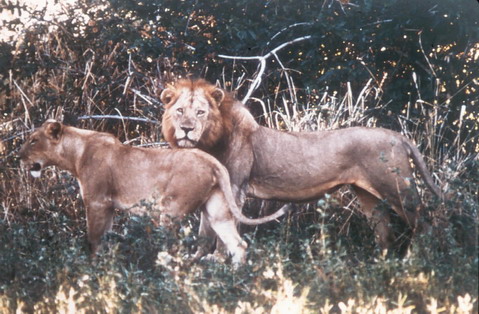The Luangwa Valley is famous because of its walking safaris and this is without doubt the most thrilling way of seeing the bush and game.
South Luangwa National Park located at the tail end of the Great Rift Valley covers almost 3500 square miles of Zambia's pristine wilderness. The park consists of large amounts of woodland; miombo interspersed with grass lands in the north of the park and large stands of mature ebony forming deep shade along the banks of the river.
It is the Luangwa River, slowly meandering its way through the park from north to south, which gives the park it's particul+ar character. The soft soil and shallow gradient between the north and south of the park, combine to make ideal conditions for the formation of the oxbow lakes for which South Luangwa is well known. These Oxbows eventually silt up and grass over. This is one of the elements which produce such exceptional game viewing as well as some spectacular scenery; grassy glades, magnificent stands of ebony and tranquil lagoons teaming with birdlife. The Luangwa valley is also criss crossed with sand rivers and some shallow, clear water rivers that flow all year round.
Luangwa is well known for large populations of all the major African mammals (with the exception of Rhino, which were poached to extinction in the 80s - but are being reintroduced into North Luangwa). It has a reputation for some of the best leopard sightings in Africa. This is partly because of the ideal nature of the habitat which includes thick riverine bush with plenty of cover, lots of game and some large shady trees to lie up in and also, unlike many parks in Africa, night game driving is allowed.
There are bush buck, puku, kudu, impala, zebra (although not many in the south) the indigenous Thornicroft giraffe and all the main predators, lion, leopard etc, including wild dog and the smaller predators such as genet, civet, mongoose etc. The bird life is excellent and very vocal with the oxbows and river attracting a vast number of water birds.
The game viewing is outstanding up near Mfuwe (the park entrance) where the animals are very used to vehicles all year round. Mfuwe area is also quite busy, so you have to be prepared for other vehicles which you really notice at night because of the spot lights used on night drives. The lodges around Mfuwe are usually a base from which to go into the park and with the game being so habituated in the area, it is an idea to have a night or two at the beginning of the trip for some game drives and night drives and to then head off into the bush for the walking.
The north park and Nsefu sector which has camps such as Tena Tena, Nsefu, Kaingo, Mchenja and Tafika, is particularly beautiful with some really very impressive ebony groves. These tall and majestic trees give a dreamy dappled shade to almost lawn like grass underneath and are a haven for the game. The area is also generally more open with the huge Mtanda plains and hot springs/salt pans which certainly at the beginning of the season makes for slightly easier game viewing.
Most companies have a main lodge close to Mfuwe and then several bushcamps. These are all very individual and can very easily be combined with each other. There is also the option of doing mobile walking safaris where you walk from camp to camp.
The beauty of the bushcamps is that the day is slightly more relaxed, walking is the main activity, so you feel as though you have earned the huge amounts of delicious food on offer and you really do experience the smaller things of the bush as well as, of course, the thrill of coming across the bigger game on foot.
The main season for the Luangwa is between June and October and as the season goes on, so the Luangwa river dries up leaving vast sandbanks and huge pods of hippo, all jealously guarding their own territories. The Luangwa also boasts one of the largest population of crocodile in Africa and there are some very impressive beasts to be seen basking in the sun. The animals come to the main areas of water to drink, which is obviously the river, but is also some of the oxbow lagoons that lead off the river. The drier it gets the more the animals congregate and you can get herds of over 1000 buffalo. Just after the rains in October the Luangwa bursts into flower and there are areas full of wild jasmine and other flowering shrubs. The impala drop their young and it can be a magical time of year to visit.
The Luangwa is also stunning in the emerald season. The inland areas of the park are impassable because of flooding and much of the park is made up of black cotton soil which is a nightmare in the rains. However around Mfuwe there are some great roads and the animals all concentrate around the area as the rest of the park floods. They breed, so there are lots of babies around and the rivers fill up so you can do boating activities. The bush turns emerald green and it really is a beautiful time to travel. During this season there are a couple of bush camps still open where you area able to walk or do boating safaris.
http://www.naturalhighsafaris.com/zambia/subregion/south_luangwa.html
Subscribe to:
Post Comments (Atom)

No comments:
Post a Comment